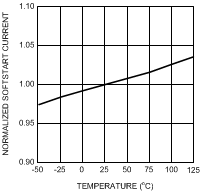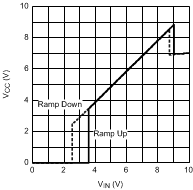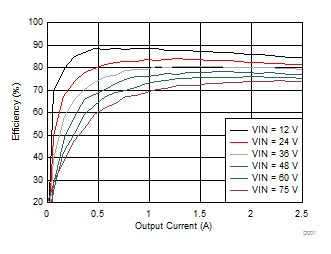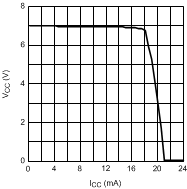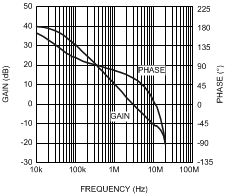SNVS397E September 2005 – November 2016 LM5005
PRODUCTION DATA.
- 1 Features
- 2 Applications
- 3 Description
- 4 Revision History
- 5 Pin Configuration and Functions
- 6 Specifications
- 7 Detailed Description
-
8 Application and Implementation
- 8.1 Application Information
- 8.2
Typical Application
- 8.2.1 Design Requirements
- 8.2.2
Detailed Design Procedure
- 8.2.2.1 Frequency Set Resistor (RT)
- 8.2.2.2 Inductor (LF)
- 8.2.2.3 Ramp Capacitor (CRAMP)
- 8.2.2.4 Output Capacitors (COUT)
- 8.2.2.5 Schottky Diode (DF)
- 8.2.2.6 Input Capacitors (CIN)
- 8.2.2.7 VCC Capacitor (CVCC)
- 8.2.2.8 Bootstrap Capacitor (CBST)
- 8.2.2.9 Soft Start Capacitor (CSS)
- 8.2.2.10 Feedback Resistors (RFB1 and RFB2)
- 8.2.2.11 RC Snubber (RS and CS)
- 8.2.2.12 Compensation Components (RC1, CC1, CC2)
- 8.2.2.13 Bill of Materials
- 8.2.3 Application Curves
- 9 Power Supply Recommendations
- 10Layout
- 11Device and Documentation Support
- 12Mechanical, Packaging, and Orderable Information
6 Specifications
6.1 Absolute Maximum Ratings
Over operating free-air temperature range (unless otherwise noted)(1)(2)| MIN | MAX | UNIT | ||
|---|---|---|---|---|
| VIN to GND | 76 | V | ||
| BST to GND | 90 | V | ||
| PRE to GND | 76 | V | ||
| SW to GND (steady state) | –1.5 | 76 | V | |
| BST to VCC | 76 | V | ||
| VCC to GND | 14 | V | ||
| BST to SW | 14 | V | ||
| OUT to GND | Limited to VVIN | V | ||
| SD, SYNC, SS, FB to GND | 7 | V | ||
| Junction temperature, TJ | –40 | 150 | °C | |
| Storage temperature, Tstg | –65 | 150 | °C | |
(1) Stresses beyond those listed under Absolute Maximum Ratings may cause permanent damage to the device. These are stress ratings only, which do not imply functional operation of the device at these or any other conditions beyond those indicated under Recommended Operating Conditions. Exposure to absolute-maximum-rated conditions for extended periods may affect device reliability.
(2) If Military/Aerospace specified devices are required, please contact the Texas Instruments Sales Office/Distributors for availability and specifications.
6.2 ESD Ratings
| VALUE | UNIT | |||
|---|---|---|---|---|
| V(ESD) | Electrostatic discharge | Human-body model (HBM), per ANSI/ESDA/JEDEC JS-001(1) | ±2000 | V |
| Charged-device model (CDM), per JEDEC specification JESD22-C101(2) | ±750 | |||
(1) JEDEC document JEP155 states that 500-V HBM allows safe manufacturing with a standard ESD control process.
(2) JEDEC document JEP157 states that 250-V CDM allows safe manufacturing with a standard ESD control process.
6.3 Recommended Operating Conditions
Over operating free-air temperature range (unless otherwise noted)(1)| MIN | MAX | UNIT | ||
|---|---|---|---|---|
| VIN | Input voltage | 7 | 75 | V |
| IOUT | Output current | 0 | 2.5 | A |
| TJ | Operating junction temperature | –40 | 125 | °C |
(1) Recommended Operating Conditions are conditions under which operation of the device is intended to be functional. For ensured specifications and test conditions, see the Electrical Characteristics.
6.4 Thermal Information
| THERMAL METRIC(1) | LM5005 | UNIT | |
|---|---|---|---|
| PWP (HTSSOP) | |||
| 20 PINS | |||
| RθJA | Junction-to-ambient thermal resistance | 35.2 | °C/W |
| RθJC(top) | Junction-to-case (top) thermal resistance | 17.8 | °C/W |
| RθJB | Junction-to-board thermal resistance | 15.5 | °C/W |
| ψJT | Junction-to-top characterization parameter | 0.4 | °C/W |
| ψJB | Junction-to-board characterization parameter | 15.3 | °C/W |
| RθJC(bot) | Junction-to-case (bottom) thermal resistance | 1.2 | °C/W |
(1) For more information about traditional and new thermal metrics, see the Semiconductor and IC Package Thermal Metrics application report.
6.5 Electrical Characteristics
Typical values correspond to TJ = 25°C. Minimum and maximum limits apply over the –40°C to 125°C junction temperature range. VIN = 48 V and RT = 32.4 kΩ (unless otherwise noted).(2)| PARAMETER | TEST CONDITIONS | MIN(1) | TYP | MAX(1) | UNIT | |
|---|---|---|---|---|---|---|
| START-UP REGULATOR | ||||||
| VVCC-REG | VCC regulator output | 6.85 | 7.15 | 7.45 | V | |
| VVCC-EXT | VCC LDO mode turnoff | 9 | V | |||
| IVCC-CL | VCC current limit | VVCC = 0 V | 20 | mA | ||
| VCC SUPPLY | ||||||
| VVCC-UV | VCC UVLO threshold | VVCC increasing | 5.95 | 6.35 | 6.75 | V |
| VVCC-HYS | VCC undervoltage hysteresis | 1 | V | |||
| IVCC | Bias current, IIN | VFB = 1.3 V | 5 | mA | ||
| ISD | Shutdown current, IIN | VSD = 0 V | 60 | 100 | µA | |
| SHUTDOWN THRESHOLDS | ||||||
| VSD-TH | Shutdown threshold | 0.5 | 0.7 | 0.9 | V | |
| VSD-HYS | Shutdown hysteresis | 0.1 | V | |||
| VSBY-TH | Standby threshold | 1.18 | 1.225 | 1.27 | V | |
| VSBY-HYS | Standby hysteresis | 0.1 | V | |||
| ISD | SD pullup current source | 5 | µA | |||
| BUCK SWITCH | ||||||
| RDS-ON | Buck switch, RDS(on) | 160 | 320 | mΩ | ||
| VBST-UV | BOOST UVLO | 3.8 | V | |||
| VBST-UV-HYS | BOOST UVLO hysteresis | 0.56 | V | |||
| RPRE | Precharge switch, RDS(on) | 75 | Ω | |||
| CURRENT LIMIT | ||||||
| ICL | Cycle-by-cycle current limit | RAMP = 0 V | 3 | 3.5 | 4.25 | A |
| TCL-DLY | Cycle-by-cycle current limit delay | RAMP = 2.5 V | 100 | ns | ||
| SOFT-START | ||||||
| ISS | SS current source | 7 | 10 | 13 | µA | |
| OSCILLATOR | ||||||
| FSW1 | Switching frequency 1 | 180 | 200 | 220 | kHz | |
| FSW2 | Switching frequency 2 | RT = 11 kΩ | 425 | 485 | 525 | kHz |
| RSYNC-SRC | SYNC source impedance | 10 | kΩ | |||
| RSYNC-SINK | SYNC sink impedance | 160 | Ω | |||
| VSYNC-FALL | SYNC threshold (falling) | 1.4 | V | |||
| FSYNC-MAX | SYNC frequency | 550 | kHz | |||
| TSYNC-MIN | SYNC pulse width minimum | 15 | ns | |||
| RAMP GENERATOR | ||||||
| IRAMP1 | Ramp current 1 | VIN = 60 V, VOUT = 10 V | 234 | 275 | 316 | µA |
| IRAMP2 | Ramp current 2 | VIN = 10 V, VOUT = 10 V | 20 | 25 | 30 | µA |
| PWM COMPARATOR | ||||||
| VCOMP-OFS | COMP to PWM comparator offset | 0.7 | V | |||
| ERROR AMPLIFIER | ||||||
| VFB | Feedback voltage | VFB = VCOMP | 1.207 | 1.225 | 1.243 | V |
| IFB-BIAS | FB bias current | 10 | nA | |||
| AOL | DC gain | 70 | dB | |||
| ICOMP | COMP sink and source current | 3 | mA | |||
| FBW | Unity gain bandwidth | 3 | MHz | |||
| THERMAL SHUTDOWN | ||||||
| TSD | Thermal shutdown threshold | 165 | °C | |||
| TSD-HYS | Thermal shutdown hysteresis | 25 | °C | |||
(1) Minimum and maximum limits are 100% production tested at 25°C. Limits over the operating temperature range are ensured through correlation using Statistical Quality Control (SQC) methods. Limits are used to calculate Average Outgoing Quality Level (AOQL).
(2) The junction temperature (TJ in °C) is calculated from the ambient temperature (TA in °C) and power dissipation (PD in Watts) as follows: TJ = TA + (PD × RθJA) where RθJA (in °C/W) is the package thermal impedance provided in Thermal Information.
6.6 Switching Characteristics
Over operating free-air temperature range (unless otherwise noted).| PARAMETER | TEST CONDITIONS | MIN | TYP | MAX | UNIT | |
|---|---|---|---|---|---|---|
| TON-MIN | Minimum controllable PWM on-time | 80 | ns | |||
| TOFF-MIN | Forced PWM off-time | 500 | ns | |||
| TPRE | Precharge switch on-time | 275 | ns | |||
6.7 Typical Characteristics
Unless otherwise specified, VIN = 48 V and VOUT = 5 V (see Typical Application for circuit designs).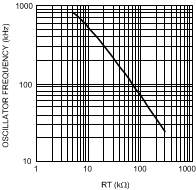
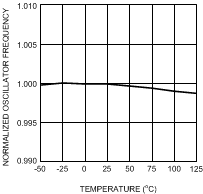
| FOSC = 200 kHz |
vs Temperature
